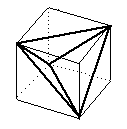
Identify the image and kernel of this homomorphism.
[Hint: think about "painting designs" on the faces of some of the figures which do have opposite symmetries.]
Describe figures whose full symmetry groups are G × < J > with G each of the possible direct symmetry groups and where J is central inversion.
Find a figures whose full symmetry group is D2nDn.
Modify this last two example to find a figure with full symmetry group C2nCn.
 Figures are formed by placing two identical oblong tiles on top of each other with their centres in the same vertical line.
Figures are formed by placing two identical oblong tiles on top of each other with their centres in the same vertical line.If the angles between their long axes are as shown:
(i) 0 (ii) π/2 (iii) π/3,
find the orders of their direct and full symmetry groups and identify these groups.
If the upper tile is coloured white and the lower one is coloured black, determine the direct and full symmetry groups in the three cases.
Every symmetry of the cube determines a permutation of the 6 faces of the cube and hence gives a group homomorphism into the permutation group S6. Write down the permutations corresponding to rotation by π/2 about centres of faces, π about centres of edges and 2π/3 about diagonals.
Which elements of S6 correspond to the opposite symmetries of the cube?